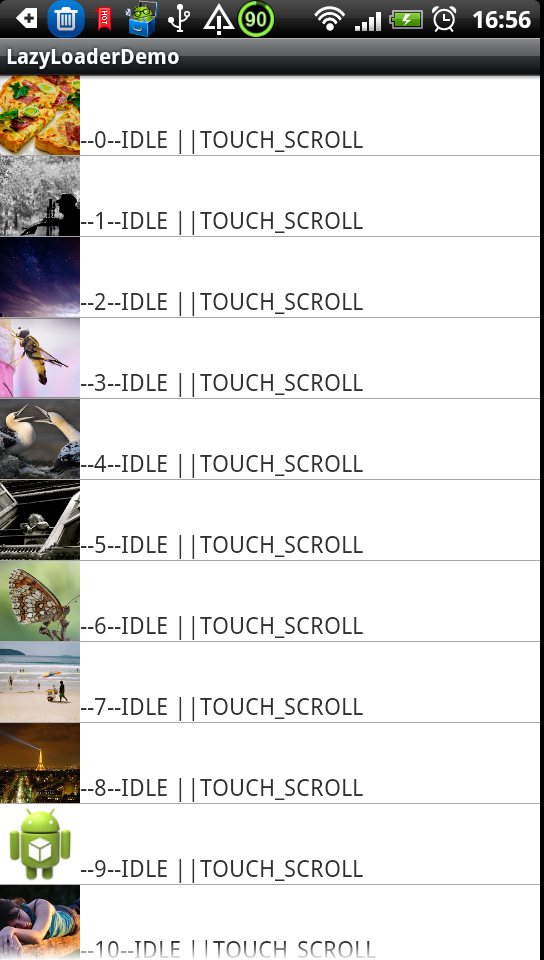Listview异步加载之优化篇
关于listview的异步加载,网上其实很多示例了,总体思想差不多,不过很多版本或是有bug,或是有性能问题有待优化。有鉴于此,本人在网上找了个相对理想的版本并在此基础上进行改造,下面就让在下阐述其原理以探索个中奥秘,与诸君共赏…
贴张效果图先:

异步加载图片基本思想:
1. 先从内存缓存中获取图片显示(内存缓冲)
2. 获取不到的话从SD卡里获取(SD卡缓冲)
3. 都获取不到的话从网络下载图片并保存到SD卡同时加入内存并显示(视情况看是否要显示)
OK,先上adapter的代码:
public class LoaderAdapter extends BaseAdapter{
private static final String TAG = "LoaderAdapter";
private boolean mBusy = false;
public void setFlagBusy(boolean busy) {
this.mBusy = busy;
}
private ImageLoader mImageLoader;
private int mCount;
private Context mContext;
private String[] urlArrays;
public LoaderAdapter(int count, Context context, String []url) {
this.mCount = count;
this.mContext = context;
urlArrays = url;
mImageLoader = new ImageLoader(context);
}
public ImageLoader getImageLoader(){
return mImageLoader;
}
@Override
public int getCount() {
return mCount;
}
@Override
public Object getItem(int position) {
return position;
}
@Override
public long getItemId(int position) {
return position;
}
@Override
public View getView(int position, View convertView, ViewGroup parent) {
ViewHolder viewHolder = null;
if (convertView == null) {
convertView = LayoutInflater.from(mContext).inflate(
R.layout.list_item, null);
viewHolder = new ViewHolder();
viewHolder.mTextView = (TextView) convertView
.findViewById(R.id.tv_tips);
viewHolder.mImageView = (ImageView) convertView
.findViewById(R.id.iv_image);
convertView.setTag(viewHolder);
} else {
viewHolder = (ViewHolder) convertView.getTag();
}
String url = "";
url = urlArrays[position % urlArrays.length];
viewHolder.mImageView.setImageResource(R.drawable.ic_launcher);
if (!mBusy) {
mImageLoader.DisplayImage(url, viewHolder.mImageView, false);
viewHolder.mTextView.setText("--" + position
+ "--IDLE ||TOUCH_SCROLL");
} else {
mImageLoader.DisplayImage(url, viewHolder.mImageView, true);
viewHolder.mTextView.setText("--" + position + "--FLING");
}
return convertView;
}
static class ViewHolder {
TextView mTextView;
ImageView mImageView;
}
}
关键代码是ImageLoader的DisplayImage方法,再看ImageLoader的实现
public class ImageLoader {
private MemoryCache memoryCache = new MemoryCache();
private AbstractFileCache fileCache;
private Map<ImageView, String> imageViews = Collections
.synchronizedMap(new WeakHashMap<ImageView, String>());
// 线程池
private ExecutorService executorService;
public ImageLoader(Context context) {
fileCache = new FileCache(context);
executorService = Executors.newFixedThreadPool(5);
}
// 最主要的方法
public void DisplayImage(String url, ImageView imageView, boolean isLoadOnlyFromCache) {
imageViews.put(imageView, url);
// 先从内存缓存中查找
Bitmap bitmap = memoryCache.get(url);
if (bitmap != null)
imageView.setImageBitmap(bitmap);
else if (!isLoadOnlyFromCache){
// 若没有的话则开启新线程加载图片
queuePhoto(url, imageView);
}
}
private void queuePhoto(String url, ImageView imageView) {
PhotoToLoad p = new PhotoToLoad(url, imageView);
executorService.submit(new PhotosLoader(p));
}
private Bitmap getBitmap(String url) {
File f = fileCache.getFile(url);
// 先从文件缓存中查找是否有
Bitmap b = null;
if (f != null && f.exists()){
b = decodeFile(f);
}
if (b != null){
return b;
}
// 最后从指定的url中下载图片
try {
Bitmap bitmap = null;
URL imageUrl = new URL(url);
HttpURLConnection conn = (HttpURLConnection) imageUrl
.openConnection();
conn.setConnectTimeout(30000);
conn.setReadTimeout(30000);
conn.setInstanceFollowRedirects(true);
InputStream is = conn.getInputStream();
OutputStream os = new FileOutputStream(f);
CopyStream(is, os);
os.close();
bitmap = decodeFile(f);
return bitmap;
} catch (Exception ex) {
Log.e("", "getBitmap catch Exception...\nmessage = " + ex.getMessage());
return null;
}
}
// decode这个图片并且按比例缩放以减少内存消耗,虚拟机对每张图片的缓存大小也是有限制的
private Bitmap decodeFile(File f) {
try {
// decode image size
BitmapFactory.Options o = new BitmapFactory.Options();
o.inJustDecodeBounds = true;
BitmapFactory.decodeStream(new FileInputStream(f), null, o);
// Find the correct scale value. It should be the power of 2.
final int REQUIRED_SIZE = 100;
int width_tmp = o.outWidth, height_tmp = o.outHeight;
int scale = 1;
while (true) {
if (width_tmp / 2 < REQUIRED_SIZE
|| height_tmp / 2 < REQUIRED_SIZE)
break;
width_tmp /= 2;
height_tmp /= 2;
scale *= 2;
}
// decode with inSampleSize
BitmapFactory.Options o2 = new BitmapFactory.Options();
o2.inSampleSize = scale;
return BitmapFactory.decodeStream(new FileInputStream(f), null, o2);
} catch (FileNotFoundException e) {
}
return null;
}
// Task for the queue
private class PhotoToLoad {
public String url;
public ImageView imageView;
public PhotoToLoad(String u, ImageView i) {
url = u;
imageView = i;
}
}
class PhotosLoader implements Runnable {
PhotoToLoad photoToLoad;
PhotosLoader(PhotoToLoad photoToLoad) {
this.photoToLoad = photoToLoad;
}
@Override
public void run() {
if (imageViewReused(photoToLoad))
return;
Bitmap bmp = getBitmap(photoToLoad.url);
memoryCache.put(photoToLoad.url, bmp);
if (imageViewReused(photoToLoad))
return;
BitmapDisplayer bd = new BitmapDisplayer(bmp, photoToLoad);
// 更新的操作放在UI线程中
Activity a = (Activity) photoToLoad.imageView.getContext();
a.runOnUiThread(bd);
}
}
/**
* 防止图片错位
*
* @param photoToLoad
* @return
*/
boolean imageViewReused(PhotoToLoad photoToLoad) {
String tag = imageViews.get(photoToLoad.imageView);
if (tag == null || !tag.equals(photoToLoad.url))
return true;
return false;
}
// 用于在UI线程中更新界面
class BitmapDisplayer implements Runnable {
Bitmap bitmap;
PhotoToLoad photoToLoad;
public BitmapDisplayer(Bitmap b, PhotoToLoad p) {
bitmap = b;
photoToLoad = p;
}
public void run() {
if (imageViewReused(photoToLoad))
return;
if (bitmap != null)
photoToLoad.imageView.setImageBitmap(bitmap);
}
}
public void clearCache() {
memoryCache.clear();
fileCache.clear();
}
public static void CopyStream(InputStream is, OutputStream os) {
final int buffer_size = 1024;
try {
byte[] bytes = new byte[buffer_size];
for (;;) {
int count = is.read(bytes, 0, buffer_size);
if (count == -1)
break;
os.write(bytes, 0, count);
}
} catch (Exception ex) {
Log.e("", "CopyStream catch Exception...");
}
}
}
先从内存中加载,没有则开启线程从SD卡或网络中获取,这里注意从SD卡获取图片是放在子线程里执行的,否则快速滑屏的话会不够流畅,这是优化一。于此同时,在adapter里有个busy变量,表示listview是否处于滑动状态,如果是滑动状态则仅从内存中获取图片,没有的话无需再开启线程去外存或网络获取图片,这是优化二。ImageLoader里的线程使用了线程池,从而避免了过多线程频繁创建和销毁,有的童鞋每次总是new一个线程去执行这是非常不可取的,好一点的用的AsyncTask类,其实内部也是用到了线程池。在从网络获取图片时,先是将其保存到sd卡,然后再加载到内存,这么做的好处是在加载到内存时可以做个压缩处理,以减少图片所占内存,这是优化三。
而图片错位问题的本质源于我们的listview使用了缓存convertView,假设一种场景,一个listview一屏显示九个item,那么在拉出第十个item的时候,事实上该item是重复使用了第一个item,也就是说在第一个item从网络中下载图片并最终要显示的时候其实该item已经不在当前显示区域内了,此时显示的后果将是在可能在第十个item上输出图像,这就导致了图片错位的问题。所以解决之道在于可见则显示,不可见则不显示。在ImageLoader里有个imageViews的map对象,就是用于保存当前显示区域图像对应的url集,在显示前判断处理一下即可。
下面再说下内存缓冲机制,本例采用的是LRU算法,先看看MemoryCache的实现
public class MemoryCache {
private static final String TAG = "MemoryCache";
// 放入缓存时是个同步操作
// LinkedHashMap构造方法的最后一个参数true代表这个map里的元素将按照最近使用次数由少到多排列,即LRU
// 这样的好处是如果要将缓存中的元素替换,则先遍历出最近最少使用的元素来替换以提高效率
private Map<String, Bitmap> cache = Collections
.synchronizedMap(new LinkedHashMap<String, Bitmap>(10, 1.5f, true));
// 缓存中图片所占用的字节,初始0,将通过此变量严格控制缓存所占用的堆内存
private long size = 0;// current allocated size
// 缓存只能占用的最大堆内存
private long limit = 1000000;// max memory in bytes
public MemoryCache() {
// use 25% of available heap size
setLimit(Runtime.getRuntime().maxMemory() / 10);
}
public void setLimit(long new_limit) {
limit = new_limit;
Log.i(TAG, "MemoryCache will use up to " + limit / 1024. / 1024. + "MB");
}
public Bitmap get(String id) {
try {
if (!cache.containsKey(id))
return null;
return cache.get(id);
} catch (NullPointerException ex) {
return null;
}
}
public void put(String id, Bitmap bitmap) {
try {
if (cache.containsKey(id))
size -= getSizeInBytes(cache.get(id));
cache.put(id, bitmap);
size += getSizeInBytes(bitmap);
checkSize();
} catch (Throwable th) {
th.printStackTrace();
}
}
/**
* 严格控制堆内存,如果超过将首先替换最近最少使用的那个图片缓存
*
*/
private void checkSize() {
Log.i(TAG, "cache size=" + size + " length=" + cache.size());
if (size > limit) {
// 先遍历最近最少使用的元素
Iterator<Entry<String, Bitmap>> iter = cache.entrySet().iterator();
while (iter.hasNext()) {
Entry<String, Bitmap> entry = iter.next();
size -= getSizeInBytes(entry.getValue());
iter.remove();
if (size <= limit)
break;
}
Log.i(TAG, "Clean cache. New size " + cache.size());
}
}
public void clear() {
cache.clear();
}
/**
* 图片占用的内存
*
* [url=home.php?mod=space&uid=2768922]@Param[/url] bitmap
*
* @return
*/
long getSizeInBytes(Bitmap bitmap) {
if (bitmap == null)
return 0;
return bitmap.getRowBytes() * bitmap.getHeight();
}
}
首先限制内存图片缓冲的堆内存大小,每次有图片往缓存里加时判断是否超过限制大小,超过的话就从中取出最少使用的图片并将其移除,当然这里如果不采用这种方式,换做软引用也是可行的,二者目的皆是最大程度的利用已存在于内存中的图片缓存,避免重复制造垃圾增加GC负担,OOM溢出往往皆因内存瞬时大量增加而垃圾回收不及时造成的。只不过二者区别在于LinkedHashMap里的图片缓存在没有移除出去之前是不会被GC回收的,而SoftReference里的图片缓存在没有其他引用保存时随时都会被GC回收。所以在使用LinkedHashMap这种LRU算法缓存更有利于图片的有效命中,当然二者配合使用的话效果更佳,即从LinkedHashMap里移除出的缓存放到SoftReference里,这就是内存的二级缓存,有兴趣的童鞋不凡一试。
好了,唠嗑了这么久也该收尾了,下面附上工程链接:
http://download.csdn.net/detail/geniuseoe2012/5046389
more brilliant,Please pay attention to my CSDN blog -->http://blog.csdn.net/geniuseoe2012